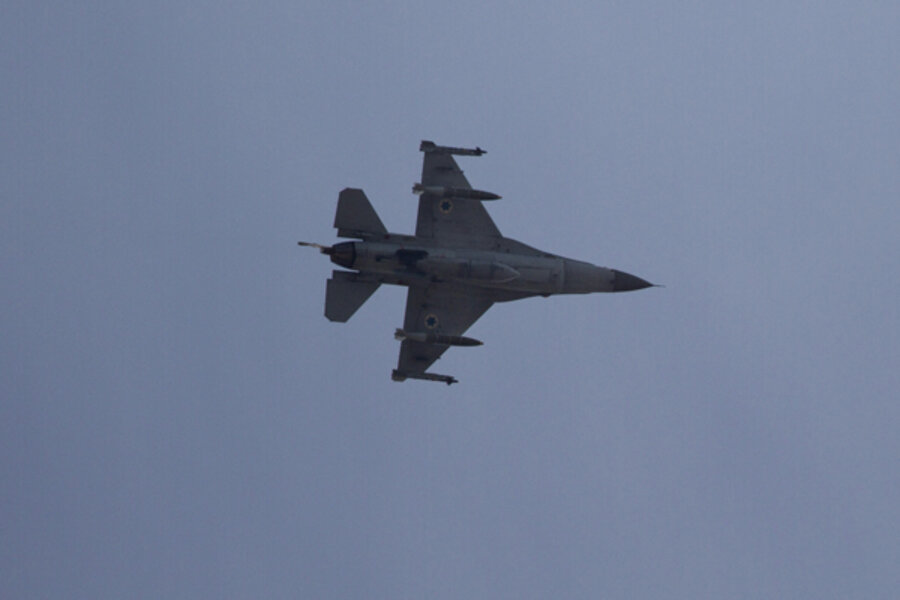Israel implies it was behind last week's airstrike in Syria, but little else is clear
Loading...
• A daily summary of global reports on security issues.
New comments have shed further light on last week's alleged Israeli airstrike into Syria, including ones in which Israel's defense minister effectively confirmed that his country was behind the attack.
Israeli Defense Minister Ehud Barak, appearing at a security conference in Munich on Sunday, all but stated explicitly that Israel was behind last week's airstrike, reports the Associated Press. Although Jerusalem has officially remained silent on the topic, Mr. Barak referred to the attack as "proof when we say something, we mean it."
"I cannot add anything to what you have read in the newspapers about what happened in Syria several days ago," Barak said. "I keep telling frankly that we said – and that's proof when we said something we mean it – we say that we don't think it should be allowed to bring advanced weapons systems into Lebanon."
Just what the airstrike targeted remains unconfirmed, though more details emerged over the weekend. Initially, multiple sources said the target was a convoy carrying advanced anti-aircraft weaponry to Lebanese militant group Hezbollah, a close ally of Syria's Assad regime and Iran.
Syria, however, has claimed that the target was a military research facility on the outskirts of Damascus. Syrian state television added support to that claim by broadcasting footage over the weekend of the site, "showing extensive damage to buildings and several heavy military vehicles which appeared capable of carrying missiles," reports Reuters.
At least one vehicle, with light desert khaki markings, was equipped with what looked like a satellite dish.
Several burnt out cars and lorries – including one with a large hole smashed through the roof of the driver's cabin - could also be seen in the footage, as well as the badly damaged interior of an office.
Making his first public response to the airstrike, President Bashar al-Assad said that Israel was trying to destabilize Syria, but that Damascus was able to confront the "current threats ... and aggression" against it.
The Washington Post reports that according to two unnamed US officials, the convoy and the military research center were the same target. They suggested that the damage suffered to the complex was the result of secondary damage from the destruction of the arms carried in the convoy, which one of the officials described as "a shipment of weapons ... potentially headed to the wrong kinds of people." The Post noted that the Syrian video of the center showed no craters that would typically indicate a direct bomb strike.
The New York Times also quotes an unnamed senior US official, who says that the Israelis "clearly went after the air defense weapons on the transport trucks." The official says that "the Israelis had [used] a small strike package" of munitions, so the attack could only have been focused on either the convoy or the center. Attacking both "would risk doing just a little damage to either."
But The Times also suggests there is reason to doubt the convoy narrative, in part because the weapons allegedly being shipped to Hezbollah, a collection of SA-17 missiles and launchers, would stand out in ways that would reflect poorly on Syria and its allies. The Times cites Ruslan R. Aliyev, an analyst with the Moscow-based defense research group Center for the Analysis of Strategy and Technologies, as saying SA-17s are too sophisticated for Hezbollah to use, and would be easily detected.
Further, he says, the Assad government's relations with Russia, one of its few international backers and supplier of its weapons, would be seriously strained were Russian-made arms to end up in Lebanon - which Assad had promised they would not.
Another of the Assad regime's key allies, Iran, attempted on Monday to use the airstrike to spur regional antagonism towards Israel. During a visit to Damascus, Iranian security chief Saeed Jalili told reporters that "Just like it regretted all its wars... the Zionist entity will regret its aggression against Syria," reports Agence France-Presse.
"The Syrian people and government are serious about this, and the Muslim world supports Syria," Jalili said.
"Syria is at the forefront of the Muslim world's confrontation with the Zionist entity," he added, in reference to Israel.








